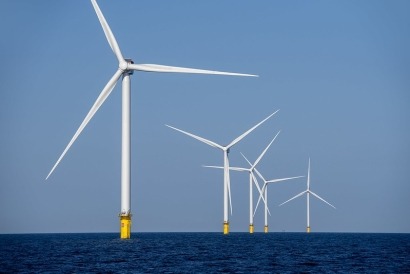
The annual electricity production is expected to equal the consumption of 1.5 million households. Hollandse Kust Zuid is owned by Vattenfall, BASF, and Allianz. The wind farm is expected to be fully operational in 2024 and will be serviced out of the port of IJmuiden.
Helene Biström, Head of Wind at Vattenfall: “Vattenfall aims to be a leader in the energy transition and offshore wind is essential for energy security and to achieve net zero. The realization of a project of this magnitude makes me really proud and today is a great example of what we can achieve when partnering with industry. Hollandse Kust Zuid will not only contribute to reducing BASF’s carbon footprint but will also help meet local businesses and households demand for fossil free electricity.”
Dr. Martin Brudermüller, Chairman of the Board of Executive Directors of BASF SE: “Hollandse Kust Zuid plays an important role in our transition toward Net Zero. Nearly half of the electricity from Hollandse Kust Zuid will be used to reduce the carbon footprint of our products at BASF sites in Europe. With this ambitious project, we continue to be a pioneer in the industry, securing green energy via direct investments. It makes me very proud that together with our strong partners, we can today inaugurate this windfarm. I’m looking forward to more such projects, as we at BASF stand firmly by our climate-neutrality commitment.”
BASF aims to reduce its greenhouse gas emissions by 25% by the year 2030 and achieve net-zero emissions by 2050. Replacing fossil-based electricity with renewable electricity is an important lever to further bring down emissions.
Oliver Bäte, CEO of Allianz: “Allianz invests policyholder funds in renewable energy and owns more than 100 wind and solar farms. I am delighted that today we are opening our first direct investment in an offshore wind farm, together with BASF and Vattenfall. This underlines the ability of partnerships to catalyse action and bring climate solutions to life.”
Allianz is committed to achieve net-zero emissions by 2050 in its proprietary investment and Property&Casualty underwriting portfolios and already by 2030 within its own operations.
Biodiversity at heart
Several innovative techniques were used during the construction of Hollandse Kust Zuid 1-4, like a double bubble screen to dampen underwater noise during pile driving to limit the impact for harbor porpoises. Enlarged water replenishment holes in the foundations offer shelter for marine life inside the turbines, the first time the structure of a turbine itself is included in nature inclusive wind farm design. Boulders and rocks of varying sizes were used during the construction of scour protection. At several scour protection sites artificial rock reefs were added to make them more attractive to a wider number of fish, crabs and crustaceans.
Circularity – recyclable blades
Three turbines are fitted with recently developed recyclable blades. The resin used to ‘glue’ blades together will be easier to dissolve after the working life of the turbines, making it easier to disseminate the blades and reuse the different elements.
Hollandse Kust Zuid is a key project in the ambitious goals that Dutch government has set to combat climate change and to provide the Netherlands with renewable energy for the next generation.
Grid connection
Two offshore substations connect Hollandse Kust Zuid to the Dutch grid. These grid connections have been developed and will be operated by the Dutch Transmission System Operator TenneT. As part of the Dutch offshore wind policy grid connections are publicly funded, which ensures standardization and subsequent cost savings. It gives wind farm developers certainty that they will not have to adjust their designs later.
Facts

